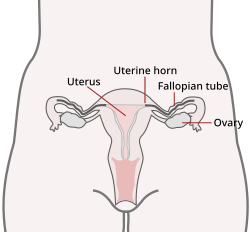Uterine horns
| Uterine horns | |
|---|---|
 Uterine horn labeled in upper right. | |
 Uterine horn not labeled, but visible. Theround ligamentis at the left, labeled as #1. It travels to the right, and attaches to theuterusat the center. Thefallopian tubeis unnumbered, but it is visible above the uterus, and travels downward to attach at a location near the round ligament. | |
| Details | |
| Identifiers | |
| Latin | cornu uteri |
| TA98 | A09.1.03.004 |
| FMA | 77053 |
| Anatomical terminology | |
Theuterine horns(cornua of uterus) are the points in the upperuteruswhere thefallopian tubesoroviductsexit to meet theovaries.They are one of the points of attachment for theround ligament of uterus(the other being themons pubis). They also provide attachment to theovarian ligament,which is located below the fallopian tube at the back, while the round ligament of uterus is located below the tube at the front.
The uterine horns are far more prominent in other animals (such as cows[1]and cats[2]) than they are inhumans.In the cat, implantation of the embryo occurs in one of the two uterine horns, not the body of the uterus itself.
Occasionally, if a fallopian tube does not connect, the uterine horn will fill with blood each month, and a minor one-day surgery will be performed to remove it. Often, people who are born with this have trouble gettingpregnantas bothovariesare functional and either may ovulate. The spareegg,that cannot travel the fallopian tube, is absorbed into the body.
References[edit]
![]() This article incorporates text in thepublic domainfrom the 20th edition ofGray's Anatomy(1918)
This article incorporates text in thepublic domainfrom the 20th edition ofGray's Anatomy(1918)
- ^Anatomy photo: Reproductive/mammal/femalesys0/femalesys6- Comparative Organology at University of California, Davis - "Mammal, female overview (Gross, Low)"
- ^Urogenital system of the female cat[dead link]- BioWeb at University of Wisconsin System
